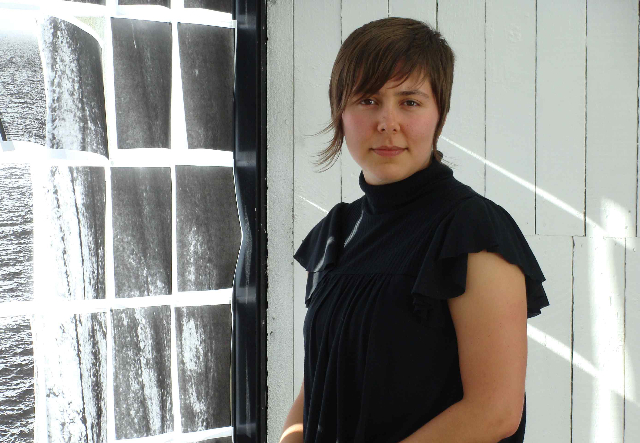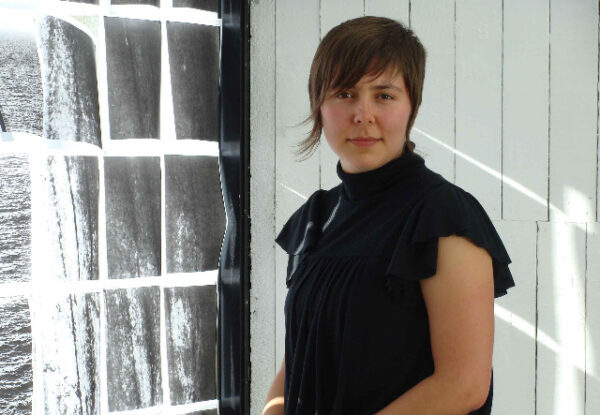Originally Posted: December 3, 2012, 10am, CIVA
An Interview with Karen Brummund, Artist in Residence, DGW 2012
By Bonnie Kate
Earlier this year, CIVA assembled thirty-some young female artists, historians, and administrators for a conference situated in scenic Vermont. The conference, Doing Good Well (or DGW,) set out to celebrate, encourage, and further train a select group of skilled women working in creative fields. I was honored to be among the attendees of the conference as an Independent Curator and Arts Administrator alongside some truly brilliant individuals from several different disciplines, counties and continents.
DGW was first held early in 2011, and has received support through the Sister Fund and Sword and Spoon Foundation. Laura Cootsona directed the conference with significant leg-work by Shannon Sigler (CIVA’s Associate Director) and their remarkable leadership team: Jinny Bult De Young, Saundra Diehl, Linda Stratford, JJ Hansen, Allison Cook, Marianne Lettieri, and Kimberly J. Miller, with 2012 apprentices Janna Dyk, Kim Garza, and artist in residence, Karen Brummund.
During this rare event, Karen Brummund engaged the attendees of DGW in a site-responsive project of interpreting the homestead façade, (298 Holiday Farms,) located on the property in Vermont. Ms. Brummund describes the process on her website saying, “Over the course of one weekend, arts professionals made images that represent this building and shared context. Their marks, both abstract and representational, are projected onto the building and blend with the physical place.” The result was an installation that both reflected Karen’s historical style of work and our very mission of sharing together in generative dialogue.
298 Holiday Farms by Karen Brummund from kmmbrummund on Vimeo.
Intrigued by Karen’s unpretentious, physical, and time-based process – she and I continued to dialogue after departing from Vermont. I began to imagine what it could be like to encounter her work in an urban setting such as my own neighborhood. Karen employs somewhat common aesthetic values such as the photocopy, or line drawings (made by collaborators with various skill levels,) and projects the interpretations of the surface onto the original. The outcome is curious, surprising, arresting, and yet accessible and familiar through her choice of media.
Below is the result of an interview that occurred over the last month between Karen and myself via email. I hope that her words and work inspire your thinking about surface, structures, and sublimity, as they have mine.
Bonnie Kate:
Karen, Tell me a little about your roots/Where you come from.
Karen Brummund:
I grew up in Atlanta.
My background is actually in education and community development. I was drawn to the philosophical aspects of education and eventually realized I was approaching curriculum development more like an artist.
In order to explore a new career path, I went to graduate school for fine art in London at the University of East London. Once I realized that I don’t like (and am not that good at) painting… I became more interested in making art outside of the studio… and interested in other artists who were working that way like Francis Alys, who had just finished a 5 year residency project with Art Angel, researching London; other younger artists were building on the (short) history of community-based art in England; and the Jerwood Center‘s exhibitions, questioning “what is drawing?”
After graduate school, I moved to Ithaca, NY. I’ve been practicing art since 2005 with little to no experience before that, (except for a great high school art education).
BK: Were there structures in Atlanta that inspired your consideration for the façade? Or was it during that time in London when this all started developing more concretely?
KB: In high school art classes, I learned how to approach art as an idea. (I left Atlanta after high school and just now moved back to the Southeast.) In college education courses, I learned to construct activities or environments where knowledge could be discovered. After college, I was working for a community-development organization, in Indianapolis; I learned how the history, structure, and culture of community affect the lives of individuals and families.
I found an interest in the façade through a few projects early in my art-making career. In 2005-2006, I had one exhibition at The Brady Art & Community Center in the East End, London where I used the outside façade like a canvas for a street level/outward facing/active drawing, and in a completely different series called the Invisible Gaze, I began installing my photographs in public space.
BK: Through your community-development lens – Do you think your work will be informed by returning to the south and having started your own family?
KB: Calling Alabama home and being a parent still feel very new. They both will change me, but I don’t know that either is pushing my work in a specific way right now. Through working in community-development, I began to see cities/places as layered and connected. I like to explore new places (Alabama included). It’s layers and landscape.
BK: Do you recall your earliest experience with a work of art? What about the work provoked you?
KB: The first art exhibition I remember attending was the “Rings” exhibition at the High Museum of Art. It was curated in conjunction with the Olympics in Atlanta.
They curated 5 large themes, like love, awe, and anger. The exhibition had a ton of paintings and sculptures. A lot of well-known works of art had been included from around the world.
The link between emotions and art moved me… being able to sense an emotion so clearly when walking into a room of paintings was a new experience.
BK: Are there any artists who you feel have inspired you – even if not evident in your work, who stick in the back of your mind?
KB: Francis Alys, Robin Rhode, and Rene Margritte.
BK: Where would you place the sacred in relation to the (at times) mundane built landscapes we encounter in our day-to-day lives?
KB: I don’t consider the buildings I work with as sacred or mundane.
Buildings might be considered one or the other because of their function, symbols, or labels.
I’m more interested in the questions and priorities that lead to mundane, branded, copied, or thoughtless landscapes and in reflecting on the dialogue that parking lots, parks, bridges, and highways create.
I like working in public space because it’s communal, complicated, and creative. But I’m not sure we require our built landscape to be that or “sacred” or even inspiring. I don’t think “sacred landscapes” should be relegated to National Parks. I want to be able to work, walk, and live in a built landscape that inspires similarly.
Maybe I work in public space to find some kind of personal sublime. I don’t want the façades or the artwork to be sublime. I don’t want the installations to be awe-inspiring. I more want them to ask why the building across the street isn’t …or maybe it is and I just stopped long enough to figure that out.
BK: Do you observe any correlations (anecdotally or ideologically) between your own artistic social practice and what could be called religious practice?
KB: Yes, the word “practice.”
Both domains are seeking to apply ideas and beliefs from one place into another. “Art” that is no longer relegated to white or black spaces, but is integrated into our living. “Religion” that is worked into our very being and working; they both are practiced in the colorful spaces.
“Practice” is a word full of “process” (my other favorite word). After the installation at DGW, a few people asked me what I consider the artwork. The artwork, “298 Holiday Farms,” is the process and memory.
It is important that the installations at DGW, and others, have the dissonance and resonance that comes when we’re “practicing” something. During the installation, the video lit up the grand homestead under an incredible starry night. But I’m not looking for a flashy, saturated moment that often comes with technology and big screens. The installation is rough, textured, and full of questions. The projection highlights the struggle to translate what we see rather than the achievements of the drawing.
At DGW, the audience was solely the people who made the images in the video projection. Therefore the installation is more personal to the audience. I talk a lot about drawing. Drawing is the immediate, physical link between what we think and what we sense. It’s the link that is most interesting to me. In the DGW installation, I want to see where the link becomes fragmented (as many participants just drew one part of the facade) …where it becomes a whole different song (as many responded abstractly or personally).
BK: And do you seek the sublime in these excavations of the facade?
KB: When I “excavate” the facade, I want something simple to be complicated. And the experience of complicated to feel rich.
When I started working on the piece for DGW (before we ever got to Vermont), I wrote this about the piece. It is the context for the process and the work of the piece:
The place where we are
The place that we share
The place we don’t know
The place we believe will come
BK: If you could work on any facade in the world, what would you take on?
KB: I loved working at Casa Poli.
The experience of living in the building before making an installation was incredible. Rather than a specific building, I would love the opportunity to live in a building and then create based on that experience.
More specifically, living in a building that is inspired – where the architects pushed themselves and the materials to create an altering experience.
BK: Do you secretly wish you were an architect?
If you had the chance to make your own “Inspired” structure, what are some of the elements you might include or borrow from others?
KB: I sometimes joke that when I retire, I’ll become an architect.
I have opinions about architecture, but I am amazed by the gifts of truly great architects. A lot of different things draw me to a building, but there are some that were simply designed to be thought about and to be felt.
I prefer buildings that don’t work too hard to draw attention to themselves, but rather transform your location or mood. They don’t need to be dressed up with decor because they create their own imaginative spaces.
It’s similar to what I look for in art: surprising, freedom, layered, and connected.
BK: Like Phillip Johnson’s Glass House? Although, I guess there aren’t really great surfaces to project onto.
KB: I would love to make a paper installation for the glass house.
BK: So, on a personal note: Your son is turning 1 year old. What is something you hope for the future of the world he will grow up in?
KB: When I think about how my artwork and my parenting overlap, especially in terms of hoping and futures, I hope for a world that better understands itself and better loves itself.
On that note, let us all engage the world in the process of becoming one that better understands itself and better loves itself, “The place we believe will come.”
Related Links:
http://studio.karenbrummund.com/wp-content/uploads/2010/08/Phillips_Brummund.pdf
http://www.nyfa.org/nyfa_current_detail.asp?id=272&fid=1&sid=17&curid=726
http://theithacapost.com/2010/09/20/chapel-reimagined/

